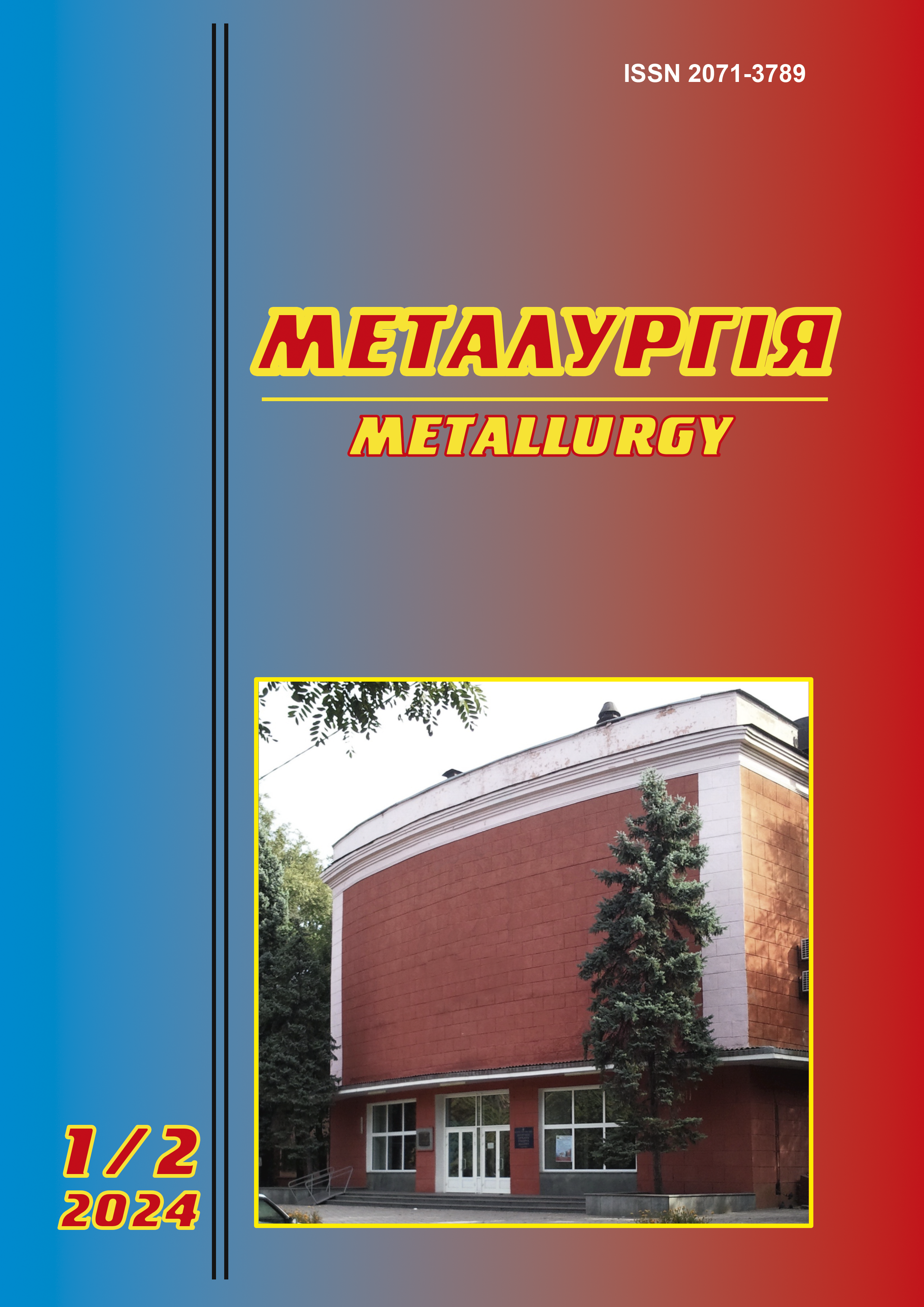STUDY OF ACID-BASE PROPERTIES OF TUNGSTEN-MOLYBDATE MELTS OF DIFFERENT CATION COMPOSITION UNDER EQUILIBRIUM CONDITIONS
Abstract
Due to their important properties, molybdenum and tungsten oxides and bronzes of different stoichiometric composition are widely used in various fields of science and technology. Melts based on tungstates and molybdates of alkaline and alkaline earth metals have practical applications for obtaining these materials. According to modern views, molybdenum and tungsten bronzes of alkaline and alkaline earth metals are solid solutions of the entry of these metals into tungsten (molybdenum) (VI) oxide. Obtaining these bronzes is carried out by chemical and electrochemical methods of synthesis. Electrochemical cells with oxygen indicator electrodes and reference electrodes are used to study changes in the activity of oxygen ions in the tungstate melt. The experimental change in the potentials of the oxygen electrode in case of addition of oxygen ion acceptors in the form of molybdates and tungstates of alkali or alkaline earth metals is explained by the proposed model of the ionic composition of the melt taking into account the formation of cationized complexes involving alkali and alkaline earth metals. Mathematical calculations of potential values of oxygen electrodes make it possible to predict the composition (number of cations) of cationized complexes. Cations Sr2+, Ba2+, Li+, Mg2+, Zn2+ interact with molybdate and tungstate anions to form the corresponding cationized complexes. The ability to form complexes increases with an increase in the specific charge of the cation. The production of molybdenum and tungsten bronzes of different compositions is determined by the possibility of changing the electroreduction potential of molybdenum and tungsten compounds, and in the case of high-temperature electrochemical synthesis, by the possibility of their displacement and combination with the potential of the second component of the synthesis.
References
2. Малишев В.В. Високотемпературна електрохімія та електроосадження металів IV-VIA груп і їх сполук в іонних розплавах : монографія. Київ : Університет “Україна”, 2004. 326 с. ISBN: 966-7979-82-0.
3. Lassner E., Schubert W.D. Tungsten: properties, chemistry, technology of the element, alloys, and chemical compounds. Springer US: Imprint: Springer, Boston, MA. 1999.
4. Granqvist C.G. Handbook of inorganic electrochromic materials. ELSEVIER. Amsterdam - Lausanne - New York - Oxford - Shannon – Tokyo. 1995. 617 р. ISBN: 9780080532905.
5. Trasorras J.R.L. Tungsten, tungsten alloys, and tungsten compounds. Wolfe in book Ullmann's Encyclopedia of Industrial Chemistry, 2000 DOI:10.1002/14356007.a27_229.pub2
6. Lekshmi I.C., Gayen A., Prasad V., Subramanyam S.V., Hegde M.S. Structure and electrical properties of sodium tungsten bronzes thin. Materials Research Bulletin, 2002. V. 37. Is. 11. P. 1815-1823. https://doi.org/10.1016/S0025-5408(02)00870-X
7. Dey K.R. Alkali Metal Tungsten Bronzes: Structural and spectroscopic properties of pure and doped alkali metal tungsten bronzes. LAP LAMBERT Academic Publishing. 2011. 144 p. ISBN-10: 3846595268 ISBN-13: 978-3846595268
8. Rahman S. Synthesis, Characterization and Structure-property Relationship of Alkali Metal Tungsten Bronzes. S. Rahman 2015. 228 p.
9. Guo J., Dong C., Yang L., Fu G. Crystal structure and electrical properties of new tungsten bronzes: BxWO3 (0,01 ≤ x ≤ 0,08). Materials Research Bulletin. 2007. V. 42, Is. 7. P. 1384-1389. DOI:10.1016/j.materresbull.2006.09.023
10. Raj S., Matsui H., Souma S., Sato T., Takahashi T., Chakraborty A., Sarma D. D., Mahadevan P., Oishi S., McCarroll W. H., Greenblatt M. Electronic structure of sodium tungsten bronzes NaxWO3 by high-resolution angle-resolved photoemission spectroscopy. Phys. Rev. 2007. V.75, Is. 15. Р. 155-116.
11. Simon A., Ravez J. Solid-state chemistry and non-linear properties of tetragonal tungsten bronzes materials. Comptes Rendus. Chimie, 2006. V. 9, Is. 10, P. 1268-1276.
12. Малишев В.В., Габ А.І., Шахнін Д.Б., Воляр Р.М., Головачев А.М. Газові кисневі електроди в йонних розплавах: типи, оборотність, електроди порівняння та шкали кислотності. Теорія і практика металургії, 2022. Т. 137, №6. С. 75-84. ISSN 1028-2335.
13. Габ А.І., Шахнін Д.Б., Малишев В.В. та ін. Вивчення кислотно-основних властивостей боровмісних вольфраматних розплавів за рівноважних умов. Металургія, 2023. Вип. 1. С. 29-38 https://doi.org/10.26661/2071-3789-2023-1-01.
14. Poignet J.-C., Fouletier J. Physico-Chemical Properties of Molten Salts. NATO Science for Peace and Security Series B: Physics and Biophysics In book: ”Materials Issues for Generation IV Systems”, 2008. P. 523-536. DOI:10.1007/978-1-4020-8422-5_26.
15. Sharma S., Ivanov A.S., Margulis C.J. A Brief Guide to the Structure of High-Temperature Molten Salts and Key Aspects Making Them Different from Their Low-Temperature Relatives, the Ionic Liquids. J. Phys. Chem, 2021. V. 125, Is. 24. P. 6359–6372 https://doi.org/10.1021/acs.jpcb.1c01065.
16. Ito, Y., Nishikiori T. Novel electrochemical reactions related to electrodeposition and electrochemical synthesis. Journal of Mining and Metallurgy, Section B: Metallurgy, 2003. V. 39, Issue 1-2. P. 233-249. https://doi.org/10.2298/JMMB0302233I.
17. Malyshev V., Gab A., Survila A., Donath C., Neacsu E.I., Popescu A.M., Constantin V. Electroplating of Co-W and Co-Mo Alloys from Na2WO4 Ionic Melts. Rev. Chim. (Bucharest). 2019. V. 70, Is. 3. P. 871-874. DOI:10.37358/RC.19.3.7023.ю
18. Malyshev V.V., Kushkhov H.B., Shapoval V.I. High-temperature electrochemical synthesis of carbides, silicides, and borides of VI-B group metals in ionic melts. J. Appl. Electrochemistry, 2002. V. 32, No. 5. P. 573-579. DOI: 10.1023/A:1016544524468.

 ISSN
ISSN 


